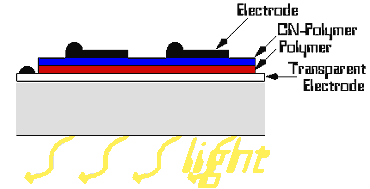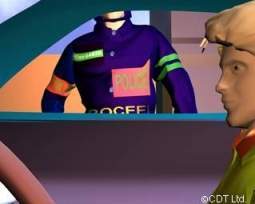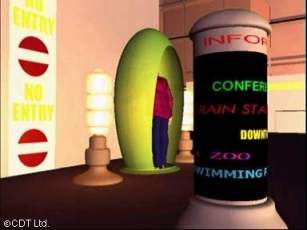Flat-packed technology - part 2
Decomposition
There were, however, several obstructions blocking the view. First, electroluminescent polymers were, in the beginning, subject to decomposition, the red conducting polymers, for instance are oxidised in sunlight. They decayed in the air, in moisture but most worryingly when an electric current was passed through them! Secondly, the glow from such materials was very weak and required a much higher voltage than even the poorest LCD. So, while the commercial incentives of flexible, lightweight displays were bright something needed to be done about making the polymers more efficient and tougher.
The task would require a special combination of skills. Expert synthetic organic chemists would need to devise ways of controlling the colour of emitted light, improving the charge affinity and balancing charge injection. While the chemists improved the materials, physicists would be able to carry out basic studies in condensed matter and develop an understanding of why the devices failed when they did. Only with this unique skills combination could the result be positive.
These unique skills came together in Cambridge in the form of University Chemical Laboratory chemist Andrew Holmes and Friend who saw the light in the late 1980s and began to go for the glow. Their collaborative team began searching in earnest for a suitable conducting polymer in the mid-1980s and hit on polyphenylene vinylene (PPV). This material is relatively stable, can be manipulated quite easily chemically and physically and, crucially, once suitably processed as a high quality thin film it gives out glows with an electric current.
Glowing report
By 1989, many of the problems were solved and the team had built its first device. A simple light-emitting polymer device - a LEP - which glowed with an eerie green. They published the work in Nature in 1990 (J. H. Burroughes et al., Nature, vol 347, p 539). The discovery process had only just begun though. The device operated far less efficiently (a mere 0.01%) than would be needed for a viable display, it needed a much higher voltage than is desirable and worst of all it still had traces of the instability that thwarted the earlier polymers, lasting only days rather than the years needed.
The team began to work on the polymers and to tweak the chemistry as well as to look at how to encapsulate the materials to extend their lifetime. At the same time they boosted efficiency to make them glow a little brighter. The team has studied various derivatives of the parent PPV and produced varying efficiencies. The ease of manipulation of this polymer means they can quite quickly test a new device for efficiency and stability under working conditions.
 They eventually came up with a construction in which a thin film of the light emitting polymer was deposited on to a single piece of glass or plastic coated with a transparent indium tin oxide electrode. Vaporised aluminium was then evaporated on top forming the circuit's second electrode. Applying an electric field between the two electrodes results in emission of light from the polymer. If the electrodes are patterned, for example in perpendicular lines, the light will be emitted from the area at the intersection of these lines.
They eventually came up with a construction in which a thin film of the light emitting polymer was deposited on to a single piece of glass or plastic coated with a transparent indium tin oxide electrode. Vaporised aluminium was then evaporated on top forming the circuit's second electrode. Applying an electric field between the two electrodes results in emission of light from the polymer. If the electrodes are patterned, for example in perpendicular lines, the light will be emitted from the area at the intersection of these lines.
Research growth
By 1992, Holmes and Friend and their growing research group began to feel that the only way to move the fledgling technology forward would be to transfer the patents to a spin-off company -
Cambridge Display Technology Ltd (CDT). With the help of Chris Smart (Cambridge Research and Innovation Ltd) and the Wolfson Industrial Unit, they went for serious financial backing away from the usual grant system and enlisted support from serial entrepreneur Hermann Hauser and the University itself. This was a unique move for the University, which had not invested in a commercial venture from its own laboratories before. 'I and the other chemists had
a big hand in encouraging the university to form a company,' explains Andrew Holmes, the team leader on the chemistry side, 'I serve on the Board as an alternate to Friend and am a consultant. Other supporters from a diverse range of backgrounds were mustered including pop group Genesis, famous for their lavish on-stage visual effects, the Sculley Brothers, the Generics Group plc, Steve Kahng, president of Power Computing Corporation, and Esther Dyson, president of Edventure Holdings.

California dreamin'
All this support gave CDT a strong base on which to build the technology and in December 1995, they showcased working LEP devices at the Flat Information Displays Conference in San Jose, California. One of these demonstrated the low-information possibilities - an LEP backlight mounted on to a conventional LCD screen. The backlight allows the LCD to be viewed in most light but without draining the batteries. Such a device will find use in mobile phones, watches, palmtop computers and electronic organisers, portable CD players, car stereos, tills, fax machines, radios, alarm clocks, and even electric razors.

At the same meeting, CDT also showed a seven-segment display of the kind used in simple digital displays but being lightweight, flexible and robust means it could have far more diverse applications than its solid-state counterparts.
There had been no doubt about their ability to carry out technology transfer so it came as no surprise when CDT, in March 1996, appointed ex-Siemens director, Danny |
Chapchal as chief executive officer (CEO). Under his guidance, the company negotiated its first commercial agreement to licence its technology to Netherlands-based Philips. Philips would take the low-information backlighting ideas and develop them into marketable products.
1997 was just as exciting for CDT with Friend being made R and D Director. This was an unusual move for a UK Professor, but would ensure that the technology would not lose sight of the science, and vice versa! By September, Lord Young of Graffham, a former Secretary of State for Trade and Industry had signed up as Chairman to CDT and pledged 6.6 million pounds to the company on behalf of his associates. The initial portion of this investment (2 million pounds) allowed CDT to boost recruitment, construct a high-level clean room and to expand into new offices on the University farm site. The rapidly ascending profile of CDT led to other major blue-chip companies chipping in with funds, among them Intel and DuPont, all eager to share in the technological potential.
Fully exposed
Then with a flourish, which led to major media exposure, in February last year, CDT and Seiko-Epson unveiled the world's first plastic TV. Seiko-Epson most famous for their high-resolution inkjet printer technology worked with CDT scientists using that very technology to 'print' the active LEP picture elements (pixels) directly on to an electronic controlling layer to build a display. The result of the collaboration, initiated in 1996, was the launch of a seemingly humble device with a green monochrome display just 50 millimetres across and just two millimetres thick. Looks can be deceptive though - this device had high enough resolution and was fast enough for a full TV picture. The concept is also compatible with adding coloured LEPs to make a full-colour display.
CDT already has the chemical know-how to create the coloured LEPs while the processing techniques used in this prototype are scaleable too, which means that jumping from small monochrome display to a full-size full-colour display are not enormous. CDT hopes to reveal a 30 centimetre full-colour device later this year. 'The collaboration with Seiko-Epson is very fruitful and the inkjet technology combined with that company's expertise in active matrix backplanes make this milestone very near,' says Holmes.
LEPs have so many advantages over even top-flight LCDs: they are far simpler to construct, visible at low voltages and use far meaner on batteries, they have a much wider viewing angle -180 degree up, down and side-to-side) they are fast switching at sub-microsecond speeds - so there is no blurring of fast video, they are robust, thin and lightweight, and will be quite literally flexible.
The earliest markets for LEPs will be in the backlighting applications and Holmes explains that Philips have started a production line at Heerlen for devices for LCD phones. The high-information displays for the notebook computer industry where size and weight make them portable and extend battery life will be the big moneyspinner - CDT estimates a 40% cost advantage for LEPs over LCDs.
Rollercoaster ride
The ultimate sci-fi dream of a huge colour TV you hang on the wall and can roll up and take away with you is not too far off now. CDT�s Light Emitting Polymer technology wasgiven Millennium Product status by the Design Council after UK Prime Minister Tony Blair challenged businesses to show Britain as a creative powerhouse. This British company is proving itself to be at the forefront of a major new technology that is set to revolutionise so many other technologies. 'CDT has been a spectacular roller coaster ride and I am delighted with the progress,' enthuses Holmes.
As a footnote to the early history of this creative powerhouse, a joint US bid was made for Cambridge Display Technology (CDT) valuing the company at more than $130 million. Kelso Investment Associates and merchant bank Hillman Capital have offered to buy a majority share of the company and CEO Danny Chapchal hopes to go for an initial public offering probably on NasDaq within two years.
 They eventually came up with a construction in which a thin film of the light emitting polymer was deposited on to a single piece of glass or plastic coated with a transparent indium tin oxide electrode. Vaporised aluminium was then evaporated on top forming the circuit's second electrode. Applying an electric field between the two electrodes results in emission of light from the polymer. If the electrodes are patterned, for example in perpendicular lines, the light will be emitted from the area at the intersection of these lines.
They eventually came up with a construction in which a thin film of the light emitting polymer was deposited on to a single piece of glass or plastic coated with a transparent indium tin oxide electrode. Vaporised aluminium was then evaporated on top forming the circuit's second electrode. Applying an electric field between the two electrodes results in emission of light from the polymer. If the electrodes are patterned, for example in perpendicular lines, the light will be emitted from the area at the intersection of these lines.

